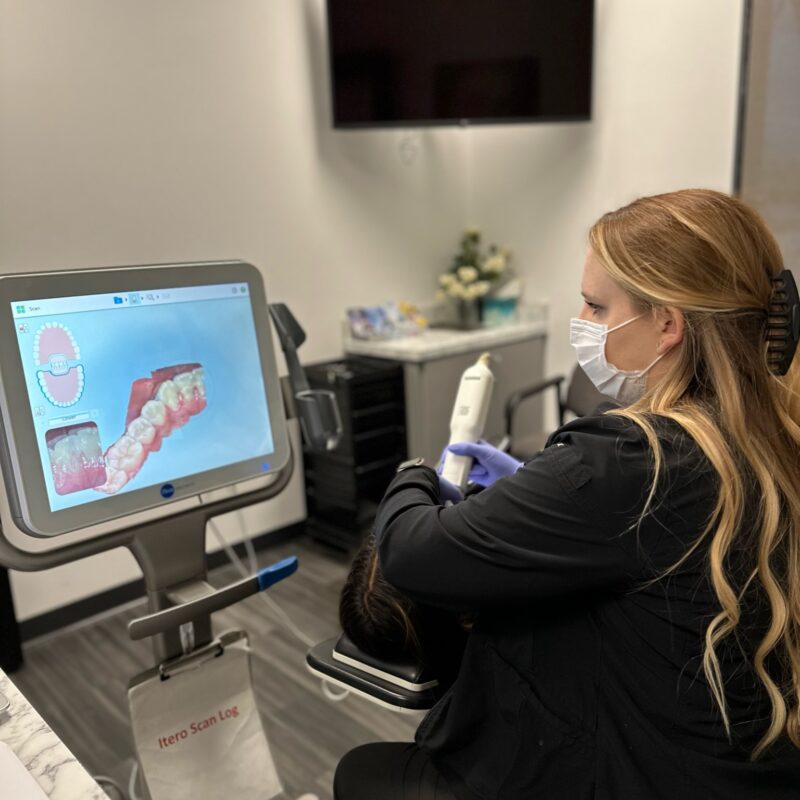A TMJ mouth splint is a specialized appliance that repositions the jaw slightly to reduce joint stress and alleviate pain caused by an improperly aligned jaw. Unlike guards that primarily prevent grinding, TMJ splints actively support alignment and muscle relaxation. They are often included as part of a long-term improvement plan for patients looking for long-term TMJ relief.

About TMJ Splint Therapy
What TMJ Splints Treat
Custom splints are effective for:
- Chronic jaw pain and tension
- Grinding or clenching leading to tooth wear
- Headaches and migraines from muscle strain
- Clicking, popping, or locking in the jaw
- Facial pain or ear discomfort related to TMJ

How a TMJ Splint Works
There are several different kinds of TMJ splints, each intended to alleviate TMJ symptoms by addressing the unique needs of the patient:
- Evaluation & Fitting – After a comprehensive evaluation, your orthodontist will craft a custom-made splint that is usually intended to be used 6 weeks or less to recapture a displaced disc or to help establish a better jaw position.
- Jaw Repositioning – The splint adjusts bite alignment slightly, easing strain on the TMJ.
- Daily or Nightly Use – Depending on severity, a splint for TMJ may be worn during the day, at night, or both.
- Therapy & Monitoring – Ongoing check-ins ensure the appliance is working as intended. TMJ splints are often part of a wider TMJ treatment plan.
TMJ Mouth Splint Care Instructions
Types and Benefits of TMJ Splints
- Stabilization or Flat Plane Splints – Cover all upper teeth to reduce grinding and relax sore jaw muscles.
- Anterior Biteplane Splints – Prevent clenching and grinding by keeping back teeth apart, typically worn at night.
- Repositioning Splints – Adjust the jaw forward or backward to help with disc displacement or bite issues (short-term use only).
- NTI-tss Devices – Fit over the front teeth to reduce clenching forces, but must be carefully monitored for safety.
Patients often notice results quickly, including reduced pain, improved jaw movement, and fewer headaches. Wearing a splint may take a few days to adjust to, especially at night. TMJ Mouth splints can offer almost immediate relief, including a reduction in headaches and jaw pain, while some patients see gradual improvement over several weeks.
Got Questions?
FAQs About TMJ Splint Therapy
How long do I need a splint for TMJ?
Duration varies, but many patients wear them for several months or longer. Some patients transition to a mouth guard to maintain correct jaw alignment and avoid teeth grinding at night.
Will a splint permanently fix TMJ?
This depends on the cause and severity of the patient’s TMJ issues. TMJ splint therapy can last a few weeks to a few months with more complicated cases that may need a combination of treatments over a longer period of time.
Can I eat with a TMJ mouth splint?
Splints are not designed for chewing so it advised you remove splints prior to eating and thoroughly rinse your mouth or brush your teeth before putting them back in.
What if my splint breaks?
Contact us promptly. Replacement is important for continued relief.

Lives Change Here
Schedule Your TMJ Splint Consultation
If you’ve been researching oral splint for TMJ to find relief, our team offers personalized care that reduces pain and restores comfort.
Book your TMJ splint therapy consultation today at our offices in Hemet and Temecula.

